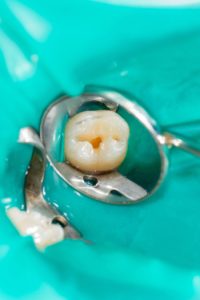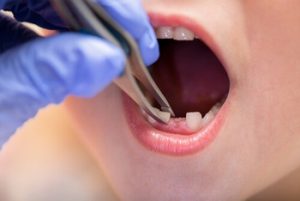Getting a tooth pulled is never a pleasant experience, but what comes after can be just as confusing, especially when unexpected things happen during recovery. One such event that raises eyebrows (and anxiety) is noticing white stuff in the tooth socket, especially when it falls out with no pain. Should you be worried? Or is this part of the body’s normal healing process?
In this article, we’ll explore the possible causes behind the white stuff that can appear and sometimes fall out after a tooth extraction, particularly when it’s not accompanied by pain. We’ll also walk you through the healing process, what’s normal, what’s not, and when you should contact your dentist.
That White Stuff in the Socket: What Is It Exactly?
After a tooth is extracted, your body immediately kicks into gear to repair the extraction site. As part of this healing process, different types of tissues form in the tooth socket. These include blood clots, granulation tissue, and sometimes other natural substances that appear white. Let’s break it down.
Granulation Tissue: The White Stuff That’s Actually a Good Sign
If you’ve noticed a white material in the area where your tooth was removed, chances are you’re looking at granulation tissue. This is a normal part of the healing process and forms after the blood clot begins to stabilise. It’s made up of white blood cells, capillaries, collagen, and other elements that support wound healing.
Granulation tissue often looks:
- Pale white or light pink
- Wet or moist in appearance
- Fragile and easily disturbed
When granulation tissue falls out with no pain, it may simply mean your body is moving through the next phase of healing. But it’s always good to understand the difference between normal and problematic changes.
Could It Be a Blood Clot That Fell Out?

If the blood clot falls out, this may expose the underlying bone and nerves. When that happens, it can lead to a painful condition called dry socket.
But what if the white stuff falls out, and there’s no pain? That suggests the blood clot has likely done its job or that what fell out wasn’t the clot at all but perhaps food debris, excess granulation tissue, or dead tissue being shed naturally.
White Stuff Fell Out, but There’s No Pain Is That Normal?
Yes, in many cases, it is normal, and it can even be a good sign. When you notice white stuff coming out of your tooth extraction site but you’re not experiencing any pain, it’s likely that your body is simply going through the natural healing process.
The most common explanations for this include:
1. Granulation Tissue Shedding Naturally
This white or pale tissue forms as your socket begins to heal. Over time, parts of this granulation tissue may naturally slough off or get replaced by new gum tissue. If a small piece falls out and you’re not in pain, it’s probably just old tissue being replaced by a normal, healthy transition.
2. Food Debris Loosening from the Socket
If you’ve been eating soft foods, especially things like rice, bread, or dairy, some food particles can settle into the socket and appear white. Eventually, these bits may be rinsed out with warm salt water, fall out on their own, or be dislodged gently when you brush around the area.
3. Fibrin Layer Breaking Away
In some cases, a whitish film you see in the socket is a protein layer called fibrin that covers wounds during healing. It helps protect the tissue underneath. As the socket improves, this layer may peel away easily, another indication of healing properly.
When It’s Not a Cause for Worry:
- There’s no foul smell or bad taste in your mouth
- You don’t notice swelling, yellow pus, or signs of infection
- The socket looks moist and pinkish underneath
- You’re not experiencing severe pain or increasing discomfort
In short, if white stuff fell out and you’re not in pain, it’s often a normal part of your body’s response to the tooth extraction. Still, it’s always better to monitor closely and reach out to your dental care provider if anything changes.
When Should You Be Concerned?
Even though no pain may suggest everything is fine, there are warning signs you should keep an eye on. These symptoms may indicate an issue such as a dry socket, infection, or delayed healing.
Signs to watch for:
- A bad taste in your mouth that doesn’t go away
- Visible bone or exposed bone
- White or yellow pus from the extraction site
- Foul smell from the socket
- Excessive bleeding
- Pain that suddenly appears after a few comfortable days
- Swelling in the jaw, cheeks, or gums
If you notice any of these, along with the white stuff falling out, you should contact your dentist immediately.
What If You Had Wisdom Teeth Removed?
After wisdom teeth are extracted, it’s very common to see white patches or material in the empty tooth socket. That can be granulation tissue, early scab tissue, or even food debris stuck in the area. This is particularly common because the back of the mouth is harder to keep clean.
Just like with other tooth extractions, if the white stuff falls out with no pain, monitor the area. If it stays clean, doesn’t swell, and doesn’t develop an odour or pus, you’re likely healing well.
Why Good Oral Hygiene Matters So Much
One of the biggest contributors to proper healing is maintaining good oral hygiene without disturbing the fragile healing site. After tooth extraction, you want to protect the blood clot, support the growth of granulation tissue, and prevent infection.
Here’s how to care for your extraction area effectively:
Do:
- Rinse with warm salt water (starting 24 hours after the extraction)
- Stick to soft foods for the first few days
- Brush gently around the extraction site
- Keep hydrated
Don’t:
- Smoke or vape (can dislodge the clot and delay healing)
- Suck through straws
- Eat crunchy or sticky foods
- Touch the socket with your fingers or tongue
Dry Socket: The One Complication You Really Want to Avoid
One of the most feared complications after a tooth is pulled is a dry socket. This happens when the blood clot becomes dislodged or never forms at all, leaving the bone and nerves exposed.

If your white stuff fell out and you begin to notice:
- Dull, aching pain within a few days
- Pain radiating to your ear, eye, or neck
- A whitish colour in the socket (indicating exposed bone)
- A socket that looks empty
Then, it’s time to contact your dental care provider. Treatment usually involves a dressing placed over the site and possibly antibiotics if infection is present.
What Does Normal Healing Look Like?
Every mouth heals a bit differently, but in general, here’s a rough timeline for normal healing after tooth extraction:
First 24 hours:
- A blood clot forms
- Mild swelling and discomfort
- Some light mouth bleeding
Days 2–3:
- Granulation tissue plays a key role
- White tissue may appear in the tooth socket
- Mild pain but manageable
Days 4–7:
- White stuff may become more visible
- You can return to a more normal diet
- Gum tissue begins to grow over the socket
Week 2:
- Significant healing of the extraction site
- Soft tissue mostly covers the area
- Little to no discomfort
What If You Accidentally Spit Something White Out?
If you’ve accidentally dislodged something white and are now worried, take a moment to observe:
- Is there any pain or swelling?
- Does the socket look red and clean or empty and pale?
- Is there any yellow pus, odd taste in your mouth, or odour?
If everything looks clean and you’re not in pain, it’s likely okay. But if you’re unsure, it’s best to schedule a follow-up to have your extraction area assessed.
Can You Prevent White Stuff From Falling Out?

- Eat soft foods like yoghurt, mashed potatoes, and scrambled eggs
- Avoid disturbing the normal socket
- Don’t use mouthwash with alcohol early on
- Use warm salt water rinses instead
- Get enough rest to support immune healing
Frequently Asked Questions
- What is the white stuff in my tooth socket after extraction?
It’s usually granulation tissue, a natural healing layer formed by your body, but it could also be food particles or debris.
- Is it bad if the white stuff falls out, but I feel no pain?
Not always. If there’s no pain, no swelling, and the socket appears clean, it’s often a normal part of healing.
- How can I tell if it’s granulation tissue or something else?
Granulation tissue is moist, pale, and fragile. Food debris may look firmer or darker. Pus is often yellow and has a bad odour or taste.
- How long does the white stuff stay in the socket?
It can remain for a week or more, depending on how your mouth heals. It gradually changes as gum tissue regenerates.
- When should I call my dentist?
If you experience severe pain, foul taste, visible bone, or yellow pus, contact your dental provider promptly.
Final Thoughts: Should You Worry?
Noticing that white stuff fell out after a tooth extraction with no pain isn’t necessarily a red flag. In most cases, it’s part of your body’s natural healing response, whether it’s granulation tissue, food debris, or a piece of fragile tissue being shed.
However, always trust your instincts. If you notice other symptoms like a bad taste, white or yellow pus, or delayed healing, call your dentist for peace of mind.
If you’re unsure about what you’re seeing in your healing socket, or you simply want reassurance, never hesitate to reach out to Advanced Dental Care Dubbo at (02) 6188 7103. Every tooth extraction is different, and monitoring your recovery is key to preventing common complications like dry sockets or infections.
Note: Any surgical or invasive procedure carries risks. Before proceeding, you should seek a second opinion from an appropriately qualified health practitioner.
References
- Mayo Clinic. (n.d.). Dry socket. https://www.mayoclinic.org/diseases-conditions/dry-socket/symptoms-causes/syc-20354376
- Cleveland Clinic. (n.d.). Wisdom teeth removal. https://my.clevelandclinic.org/health/treatments/22119-wisdom-teeth-removal
- Colgate. (n.d.). What is good oral hygiene? https://www.colgate.com/en-us/oral-health/adult-oral-care/what-is-good-oral-hygiene
- Verywell Health. (n.d.). How to make a saline solution for a salt water mouth rinse. https://www.verywellhealth.com/how-to-make-saline-solution-salt-water-mouth-rinse-4109216







